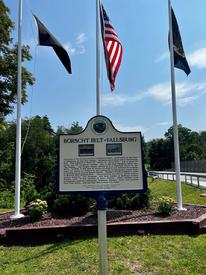 |
| Fallsburg |
|
| Borscht Belt - South Fallsburg
Once referred to as the "King of the Catskills," South Fallsburg was home to a vast selection of hotels and bungalow colonies for those seeking community, leisure, and entertainment. Originally boosted by the railroad, by the 1950s the town reached the pinnacle of its vibrant Borscht Belt history and was the location for several resorts including the Brickman, Gilbert's, Heiden, Irvington, Nemerson, Pines, Raleigh, Schenk's and Windsor hotels. They shared similar amenities - 200-500 rooms, indoor and outdoor pools, ample sporting facilities, large nightclubs, and modern architecture and design. Modern design is characteristically colorful and utilizes organic shapes and geometric forms.Examples of this modern style were found at the Pines with its kidney-shaped pool and distinctive concrete arched bridge. Schenk's featured an abstract sculpture and circular card room with stained-glass windows, abstract murals, spiral staircases, and sleek furnishings. South Fallsburg was also home to many bungalow colonies, including Cutler's, Dishner's, Elm Shade, Gold and Rados, Pancrest Lodge,
Sun Ray Cottages, and Skopp's. -side 2-
The exclusion of the Jewish community from existing establishments in the 1920s drove Jewish entrepreneurs to create over 500 resorts, 50,000 bungalows and 1,000 rooming houses in Sullivan County and parts of Ulster County. The Borscht Belt provided a sense of community for working and vacationing Jews. The era exerted a strong influence on American culture, particularly in the realm of entertainment, music, and sports. Some of the most well-known and influential people of the 20th century worked and vacationed in the areas. Beginning around 1960, the Borscht Belt began a gradual demise due to many factors including the growth of suburbia, inexpensive airfare and generation changes.
|